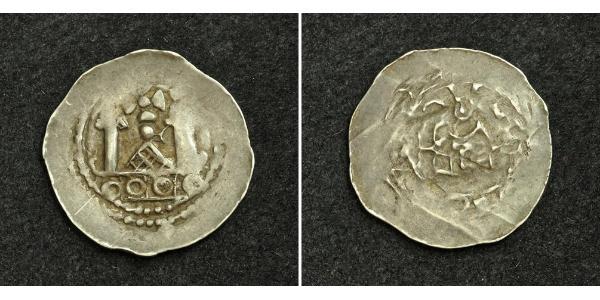(sold for $32.0)
1200, Archbishops of Gurk. Scarce Silver Friesach Pfennig Coin. Pilstanj mint!
Denomination: Pfennig
Mint Period: ca. 1200
References: CNA Cq1 (E.34) var. R!
Mint Place: Pilstanj (Peilenstein, Carinthia)
Condition: Crudely struck reverse, otherwise VF+
Diameter: 21mm
Material: Silver
Weight: 1.38gm
Obverse: Stylized depiction of a church consisting of a centrla pyramid-like building topped by a cross and flanked by two towers. Four annulets below.
Reverse: Bust of bishop (barely visible).
Friesach (Slovene: Breže) is a town in the district Sankt Veit an der Glan, Carinthia, Austria. It is known as the oldest town in Carinthia. Friesach was first mentioned in an 860 document when the land around the estate of Friesah was donated by Louis the German to Archbishop Adalwin of Salzburg. About 1076 Gebhard of Salzburg, a follower of Pope Gregory VII in the Investiture Controversy, had the fortress of Petersberg erected above the town in order to prevent Emperor Henry IV from crossing the Alps. Gebhard had fierce enemies in the ducal House of Sponheim, who after his deposition made several attempts to take possession of Friesach. The attacks by Duke Engelbert were finally rejected in 1124. In 1149 King Conrad III stayed at the castle on his way back from the Second Crusade, as well as Richard the Lionheart in 1192, one more time escaping from the guards of Duke Leopold V of Austria. The fortress remained an important power basis of the Salzburg Archbishops, once again strengthened by Leonhard von Keutschach from 1495. The settlement of Friesach received town privileges in 1215. During the Middle Ages, it was a principal market town and commercial centre due to an important trade route from Vienna to Venice that ran through the city. The town flourished when Archbishop Eberhard II of Regensberg (1200-1246) made it the second largest city in the Archdiocese of Salzburg and the most important town in Carinthia. At a time it even minted its own currency called the Frizatik. Upon the Mediatisation of Salzburg in 1803, Friesach fell to the Duchy of Carinthia.
Authenticity unconditionally guaraneed.
The Roman Catholic Diocese of Gurk (Latin: Dioecesis Gurcensis, German: Diözese Gurk, Slovene: Krška škofija) is a diocese comprising the Austrian state of Carinthia and is part of the ecclesiastical province of Salzburg.
In 1072 a suffragan bishopric in the Duchy of Carinthia, subordinate to the Archdiocese of Salzburg, was erected by Archbishop Gebhard of Salzburg, with the authorization of Pope Alexander II (21 March 1070) and Emperor Henry IV (4 February 1072). It could rely on the properties of a former nunnery in Gurk founded by Countess Hemma in 1043. The first bishop installed was the local noble Günther von Krapffeld (1072–90). The episcopal residence was not in Gurk, but at nearby Strassburg Castle.
Initially the Gurk bishops only held the rights of vicars, while the right of appointment, consecration, and investiture was reserved to the Salzburg archbishop. The diocese served as a model for later Salzburg establishments like the Bishopric of Chiemsee (1216), the Diocese of Seckau, and the Diocese of Lavant (1228). Not until 1123 Archbishop Conrad I of Salzburg founded a cathedral chapter at Gurk, which under Bishop Roman I (1132–67) obtained the right to elect the bishop. The boundaries of the diocese were only defined in 1131. Originally the territory embraced was small, but the jurisdiction of the Bishop of Gurk extended beyond the limits of his diocese, inasmuch as he was also vicar-general of that part of Carinthia under the Archbishop of Salzburg. The rights of a secular Vogt advocate were held by the Carinthian dukes.
After a contest of a hundred years the metropolitan regained the right of appointment. Dissensions did not cease, for in 1432 the Habsburg duke Frederick IV of Austria claimed the right of investiture, which even was a subject of the consultations at the Council of Basel under Pope Eugene IV. In 1448 King Frederick IV of Germany concluded an agreement with Pope Nicholas V to reserve the right of appointment for himself and when in 1470 Sixtus of Tannberg was appointed Gurk bishop by the Salzburg chapter, Frederick enforced his resignation four years later. Finally, on 25 October 1535, the Archbishop of Salzburg and former Gurk bishop, Matthäus Lang von Wellenburg, concluded a long-lasting agreement with King Ferdinand I of Germany, according to which the nomination of the Bishop of Gurk is to rest twice in succession with the sovereign and every third time with the Archbishop of Salzburg; under all circumstances the archbishop was to retain the right of confirmation, consecration and investiture. Though from 1460 onwards the Gurk bishops held the right to bear the title of a prince-bishop, they never exerted any secular power.

|
Posted by:
anonymous 2015-01-23 |
1 Tetradrachm Seleucid Empire (312BC-63 BC) Silver
group has 20 coins / 19 prices
⇑
1 Krone Austria-Hungary (1867-1918) Silver Franz Joseph I (1 ...
group has 17 coins / 14 prices
⇑















-300-150-yP0Kbzbi2McAAAFLXn2jlsyK.jpg)

-300-150-yTrBwcI0z7EAAAEmG8UxGksz.jpg)






